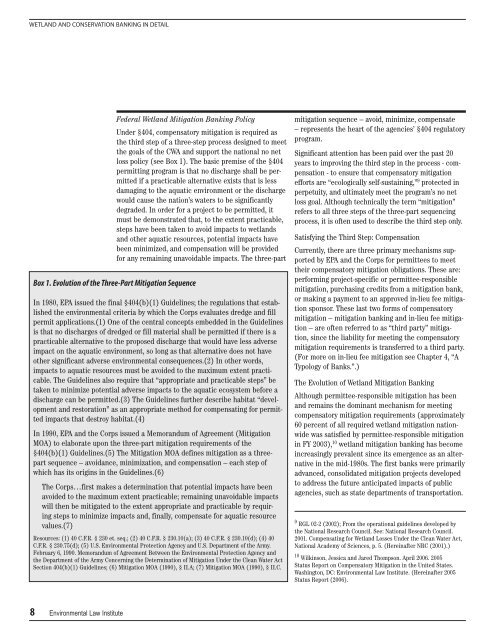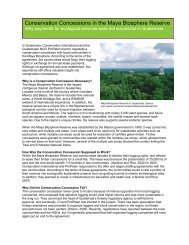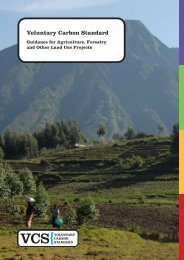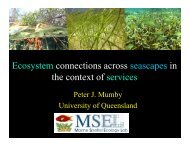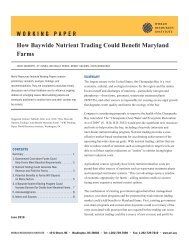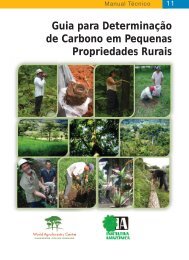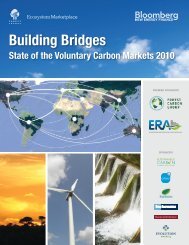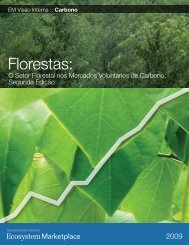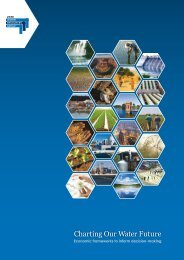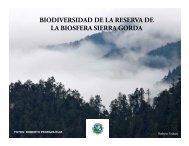Design of US Habitat Banking Systems to Support the Conservation ...
Design of US Habitat Banking Systems to Support the Conservation ...
Design of US Habitat Banking Systems to Support the Conservation ...
Create successful ePaper yourself
Turn your PDF publications into a flip-book with our unique Google optimized e-Paper software.
WETLAND AND CONSERVATION BANKING IN DETAILFederal Wetland Mitigation <strong>Banking</strong> PolicyUnder §404, compensa<strong>to</strong>ry mitigation is required as<strong>the</strong> third step <strong>of</strong> a three-step process designed <strong>to</strong> meet<strong>the</strong> goals <strong>of</strong> <strong>the</strong> CWA and support <strong>the</strong> national no netloss policy (see Box 1). The basic premise <strong>of</strong> <strong>the</strong> §404permitting program is that no discharge shall be permittedif a practicable alternative exists that is lessdamaging <strong>to</strong> <strong>the</strong> aquatic environment or <strong>the</strong> dischargewould cause <strong>the</strong> nation’s waters <strong>to</strong> be significantlydegraded. In order for a project <strong>to</strong> be permitted, itmust be demonstrated that, <strong>to</strong> <strong>the</strong> extent practicable,steps have been taken <strong>to</strong> avoid impacts <strong>to</strong> wetlandsand o<strong>the</strong>r aquatic resources, potential impacts havebeen minimized, and compensation will be providedfor any remaining unavoidable impacts. The three-partBox 1. Evolution <strong>of</strong> <strong>the</strong> Three-Part Mitigation SequenceIn 1980, EPA issued <strong>the</strong> final §404(b)(1) Guidelines; <strong>the</strong> regulations that established<strong>the</strong> environmental criteria by which <strong>the</strong> Corps evaluates dredge and fillpermit applications.(1) One <strong>of</strong> <strong>the</strong> central concepts embedded in <strong>the</strong> Guidelinesis that no discharges <strong>of</strong> dredged or fill material shall be permitted if <strong>the</strong>re is apracticable alternative <strong>to</strong> <strong>the</strong> proposed discharge that would have less adverseimpact on <strong>the</strong> aquatic environment, so long as that alternative does not haveo<strong>the</strong>r significant adverse environmental consequences.(2) In o<strong>the</strong>r words,impacts <strong>to</strong> aquatic resources must be avoided <strong>to</strong> <strong>the</strong> maximum extent practicable.The Guidelines also require that “appropriate and practicable steps” betaken <strong>to</strong> minimize potential adverse impacts <strong>to</strong> <strong>the</strong> aquatic ecosystem before adischarge can be permitted.(3) The Guidelines fur<strong>the</strong>r describe habitat “developmentand res<strong>to</strong>ration” as an appropriate method for compensating for permittedimpacts that destroy habitat.(4)In 1990, EPA and <strong>the</strong> Corps issued a Memorandum <strong>of</strong> Agreement (MitigationMOA) <strong>to</strong> elaborate upon <strong>the</strong> three-part mitigation requirements <strong>of</strong> <strong>the</strong>§404(b)(1) Guidelines.(5) The Mitigation MOA defines mitigation as a threepartsequence – avoidance, minimization, and compensation – each step <strong>of</strong>which has its origins in <strong>the</strong> Guidelines.(6)The Corps…first makes a determination that potential impacts have beenavoided <strong>to</strong> <strong>the</strong> maximum extent practicable; remaining unavoidable impactswill <strong>the</strong>n be mitigated <strong>to</strong> <strong>the</strong> extent appropriate and practicable by requiringsteps <strong>to</strong> minimize impacts and, finally, compensate for aquatic resourcevalues.(7)Resources: (1) 40 C.F.R. § 230 et. seq.; (2) 40 C.F.R. § 230.10(a); (3) 40 C.F.R. § 230.10(d); (4) 40C.F.R. § 230.75(d); (5) U.S. Environmental Protection Agency and U.S. Department <strong>of</strong> <strong>the</strong> Army.February 6, 1990. Memorandum <strong>of</strong> Agreement Between <strong>the</strong> Environmental Protection Agency and<strong>the</strong> Department <strong>of</strong> <strong>the</strong> Army Concerning <strong>the</strong> Determination <strong>of</strong> Mitigation Under <strong>the</strong> Clean Water ActSection 404(b)(1) Guidelines; (6) Mitigation MOA (1990), § II.A; (7) Mitigation MOA (1990), § II.C.mitigation sequence – avoid, minimize, compensate– represents <strong>the</strong> heart <strong>of</strong> <strong>the</strong> agencies’ §404 regula<strong>to</strong>ryprogram.Significant attention has been paid over <strong>the</strong> past 20years <strong>to</strong> improving <strong>the</strong> third step in <strong>the</strong> process - compensation- <strong>to</strong> ensure that compensa<strong>to</strong>ry mitigationefforts are “ecologically self-sustaining,” 9 protected inperpetuity, and ultimately meet <strong>the</strong> program’s no netloss goal. Although technically <strong>the</strong> term “mitigation”refers <strong>to</strong> all three steps <strong>of</strong> <strong>the</strong> three-part sequencingprocess, it is <strong>of</strong>ten used <strong>to</strong> describe <strong>the</strong> third step only.Satisfying <strong>the</strong> Third Step: CompensationCurrently, <strong>the</strong>re are three primary mechanisms supportedby EPA and <strong>the</strong> Corps for permittees <strong>to</strong> meet<strong>the</strong>ir compensa<strong>to</strong>ry mitigation obligations. These are:performing project-specific or permittee-responsiblemitigation, purchasing credits from a mitigation bank,or making a payment <strong>to</strong> an approved in-lieu fee mitigationsponsor. These last two forms <strong>of</strong> compensa<strong>to</strong>rymitigation – mitigation banking and in-lieu fee mitigation– are <strong>of</strong>ten referred <strong>to</strong> as “third party” mitigation,since <strong>the</strong> liability for meeting <strong>the</strong> compensa<strong>to</strong>rymitigation requirements is transferred <strong>to</strong> a third party.(For more on in-lieu fee mitigation see Chapter 4, “ATypology <strong>of</strong> Banks.”.)The Evolution <strong>of</strong> Wetland Mitigation <strong>Banking</strong>Although permittee-responsible mitigation has beenand remains <strong>the</strong> dominant mechanism for meetingcompensa<strong>to</strong>ry mitigation requirements (approximately60 percent <strong>of</strong> all required wetland mitigation nationwidewas satisfied by permittee-responsible mitigationin FY 2003), 10 wetland mitigation banking has becomeincreasingly prevalent since its emergence as an alternativein <strong>the</strong> mid-1980s. The first banks were primarilyadvanced, consolidated mitigation projects developed<strong>to</strong> address <strong>the</strong> future anticipated impacts <strong>of</strong> publicagencies, such as state departments <strong>of</strong> transportation.9 RGL 02-2 (2002); From <strong>the</strong> operational guidelines developed by<strong>the</strong> National Research Council. See: National Research Council.2001. Compensating for Wetland Losses Under <strong>the</strong> Clean Water Act,National Academy <strong>of</strong> Sciences, p. 5. (Hereinafter NRC (2001).)10 Wilkinson, Jessica and Jared Thompson. April 2006. 2005Status Report on Compensa<strong>to</strong>ry Mitigation in <strong>the</strong> United States.Washing<strong>to</strong>n, DC: Environmental Law Institute. (Hereinafter 2005Status Report (2006).8 Environmental Law Institute


